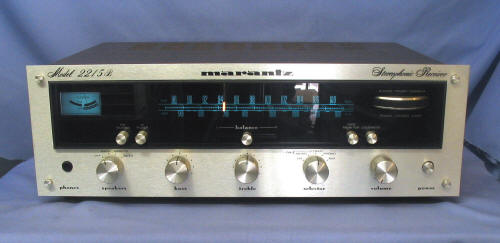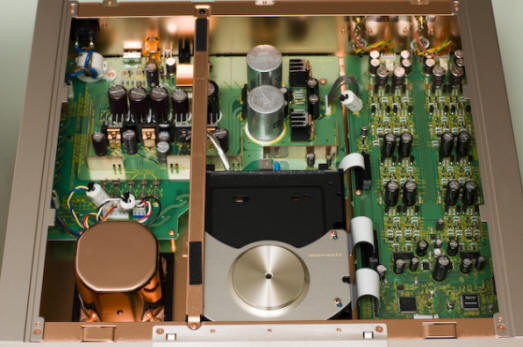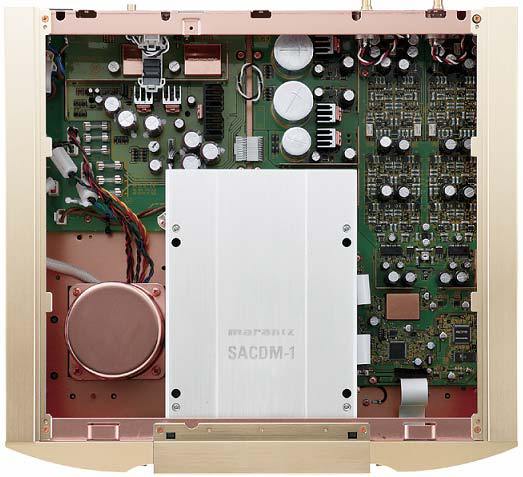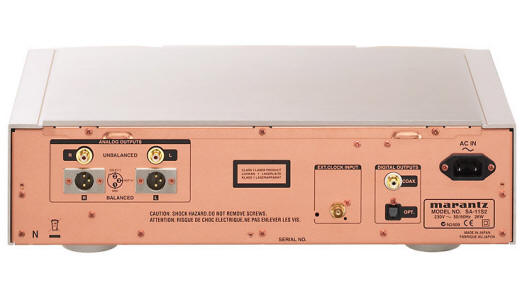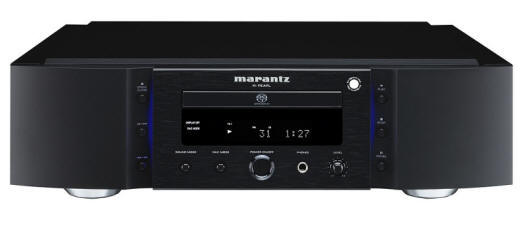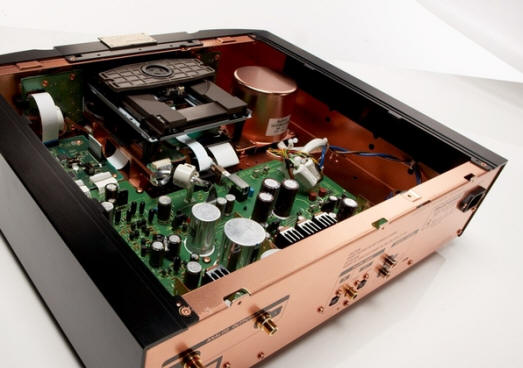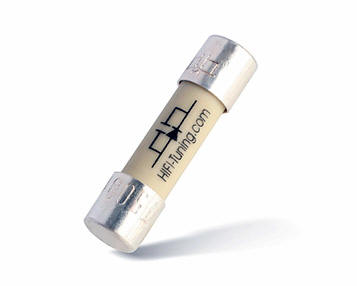|
You are reading the older HTML site
Positive Feedback
ISSUE
52
Marantz SA-11s2 and the KI Pearl... With Some Slight
Modifications to Raise the Bar Sonically!
Coming of age… It all began the Summer of 1975 when I was 15. After listening to my friend's separate Pioneer receiver, a Dual turntable and pair of Advent speakers I was hooked. Motivated to acquire my own piece of stereo heaven, I threw newspapers for the San Diego Union's early morning delivery. For a little over a year I got up at 3:30AM to fold all of my 135 papers, and then load them on my bike. I had them all delivered (all of which were on their respective porch) by 6:00AM. It took a year of saving but I finally managed to save up $600. With cash in hand for my 16th birthday I bought my first "true" Hi-Fi at Dow Stereo (long gone) in San Diego. My first real Hi-Fi consisted of a BIC 2 turntable with a Grado cartridge, a Marantz 2215 receiver, and a pair of Advent 1 loudspeakers that I had purchased from Sound Company-a business that is still around to this day. In addition to kicking in a couple bucks toward the cause, my father bought me my first stereo cassette player-recorder—a Hitachi D-230. I wondered why I needed a cassette recorder, but later on I found out why. That weekend my father passed on his 1973 Oldsmobile Omega to me for my birthday since he had just bought a new car. His new car was a Volvo 240 equipped with a Blaupunkt AM/FM stereo cassette player. Dad bought the Hitachi stereo cassette recorder so that I could tape his large vinyl collection to cassette. Knowing I was already into playing around with recording devices, I gladly obliged. Having a car and a new Hi-Fi, I was the coolest teenager on the block! My 16th birthday was the best. I will never forget it! I loved that first rig. I played it for hours on end. It brought many hours of pure joy while at the same time driving my parent's nuts who were constantly yelling at me to "turn that damn thing down." Maybe that is why dad gave me a car—to get me out of the house! Even though my system has clearly evolved since I was 16, there still is something very special about your first Hi-Fi.
Going back to the 1970's Marantz products have always had a special place in my heart. I always loved the beautiful music my Marantz 2215 receiver made when it served as the heart of my first "real" Hi-Fi system. Oh that Gyroscope tuner…, who can forget that? For those of us who owned Marantz receivers from the 1970's that Gyroscope tuner dial was so cool. Admit it, it was great fun to spin the tuner dial where it effortlessly tuned across the channels from one pass of your finger flicking it. It has been over 30 years since I have had anything in my system with the Marantz name on it due to their focus upon the mid-fi mass market. However, things have changed. Through the efforts of Ken Ishiwata (Marantz's Chief Engineer) Marantz has clearly entered the high end audio market with their "Reference Series" starting with the Marantz SA-1 SACD player in 2001. Fast forward nine years later, and we are looking at Marantz SA-11s2.
Features and facts… Introduced in 2008, the Marantz SA-11s2 replaces the SA-11s1 which has served the Marantz reference line well since 2004. Like the SA-11s1, the SA-11s2 is placed right in the middle between the top-of-the-line SA-7s1, the limited edition SA-KI Pearl which gets its name from Ken Ishiwata's initials of KI, and the SA-15s2. With the KI Pearl being the only exception offered in Black Pearl, the SA-11s2 as well as the rest of the Marantz Reference line retains a retro look paying homage to Sol Marantz's tube based gear of the 1960's. Add that unique Champagne color to the faceplating and case as opposed to traditional silver or black, and I believe not only is the SA-11s2 retro looking but classy at the same time—even my wife took notice stating, "That looks nice."
Lots of changes have been made regarding the SA-11s2, it is more similar to its "top shelf" brother than the SA11s1 it replaced. The new features of the SA-11s2 are as follows: Originally developed for the SA-7s1, the SA-11s2 now uses the same SACDM-1 transport laser mechanism as the SA-7s1. This drive mechanism uses a solid cast aluminum tray, and solid 10mm thick aluminum case that houses the SA-11s2s transport. This feature helps cut down issues with mechanical induced jitter which can rob a player of its focus. Gone is the CD drawer attributed to the SA-11s1 where the drawer did not completely extend out of the unit. Now the end user can place their precious CDs or SACDs into the player with ease, thus, preventing one from loading the disc improperly into the drive—a complaint common with SA-11s1 users. New for the SA-11s2 is a selectable DC filter. The purpose of this filter is to remove extraneous ultra low-frequency signals that are unrelated to source audio signals. However, these signals can and often do affect sound quality. By allowing the end user to turn this switch on or off they can fine tune the ambiance of the player. Trickling down from the SA-7s1 is a custom made PEC777F digital filter for the SA-11s2 that features a high-performance 24bit DSP with an original algorithm that directly supports superior oversampling (8x). Advantages of this new filter are eliminating out-of-band noise which improves signal to noise ratio and dynamic range. Within this digital filter there are three user selectable digital filters that offer changes to the SA-11s2s voicing both for SACD and CD play back. My favorite for SACD is filter 1, and for CD filter 3—your choice may be different. Another improvement regarding SA-11s2 is the servo and decoder are now mounted on their own separate four-layer glass epoxy board. This assembly has been developed for audio use only with the PCB layout being optimized for low noise and low impedance. Again, all improving the SA-11s2 performance as compared to the SA-11s1. The SA-11s2 gets a new pair of Seiko NPC SM5866AS DACs that are compatible with DSD and PCM signals. Used as mono pairs which helps eliminate crosstalk. Another improvement based upon the use of the Seiko DACs offering jitter free operation, compensating for jitter if the system clock and word clock are out of phase. This improves focus and inner detail as compared to the older SA-11s1. In my opinion the biggest upgrade taken directly from the SA-7s1 is fully balanced dual differential audio circuits and output stage. Now the SA-11s2 is fully balanced from input to output. These improvements also include the famous proprietary Marantz HDAM circuitry in a DUAL mono pair HDAM configuration, with two HDAM circuits for the I/V converter, and low pass filter. This is all followed in the final output stage of the player by the respective HDAM-SA2s. Get this there are NO OPAMPS used anywhere within the design of the SA-11s2. Another change, and something that I believe has a lot to do with the SA-11s2s fantastic bass response and improved dynamic range, is an upgrade from a 60VA toroidal transformer to the current 80VA transformer. Within this, oversized transformer wiring is channeled into separate circuits with separate sets for digital, audio and LCD display, thus, eliminating crosstalk interference between circuits. In addition, this powerful toroidal transformer is double shielded by an aluminum shorting and copper plated can. All of this helps eliminate EMI and RFI distortions that clearly affect how a player can sound.
The SA-11s21s2 now benefits from two high precision quartz clocks, one for PCM signals (CDs) and the other for DSD (SACDs), and a new linear-voltage regulator. Again this helps with jitter reduction, and is one of the reasons why the SA-11s2 sounds great whether playing SACDs or CDs though it. Often I have found in the past when a single clock is shared between these two different technologies, compromises are made in sound reproduction—usually with one format of the two not sounding its best as compared when each have their own separate dedicated clock. The final trickle down from the SA-7S1 for the SA-11s2 is a digital phase inverter. This allows the end user to invert phase regarding the output of the SA-11s2 so that is can provide an ideal match to the preamplifier since there are different balanced configurations for both European and US based balanced circuits. Now the end user can match the SA-11s2 to any preamplifier available in the world and not have to worry whether or not the player in phase with the rest of his or her system. I have found this a very cool feature, especially if you are running several different sources. We all know the SA-11s2 is built like a tank with its solid aluminum case that features a double-layer copper coasted chassis and rear panel. As usual the SA-11s2 features RCA outputs, fully balanced XLR outputs, RCA and optical digital outputs, and an output for an external clock.
New is the top cover for SA-11s2 which is made from a solid piece 5mm aluminum. All of these improvements make for a sonically dead chassis where the effect of outside resonance is placed to a minimum. Besides the casing of the SA-11s2, one thing that did capture my attention prior to listening to it was its remote. Usually I am not one to discuss a remote in too much detail for a SACD/CD player knowing most remotes are just remotes. Often when I do discuss the remote of a product it is due to me complaining about something I didn't like about it. What is refreshing is that this is clearly NOT the case regarding Marantz and the remote supplied with the SA-11s2. It is solidly built with an all aluminum top faceplate that has a well done matching case, and it fits very nicely into my hand . What I like best about the remote is it features all of my favorite remote creature comforts including: a display on/off dimmer, time displays, repeat all or single track command, shuffle commands, and the ability to change the player's three different digital filters from the comfort of your seat (though you do have to stop the player to change filter settings.) All in all a pretty well thought out remote. For $3500 and now with its newly reduced retail of $3000, I have yet to find a SACD/CD player built to the same standard as the SA-11s2 within its price range! Why review the SA-11s2 now? Yep, I can clearly understand that question—especially when I asked the same question to myself as well. With the SA-11s2 being out for almost three years, why review a player that has been reviewed by so many in the past? Does the SA-11s2 really need "another" review? Hasn't it already been reviewed to death? When I commissioned the SA-11s2 for review I thought the same thing. Why do I want to review a player that has been through so many well qualified hands in the past? At first when I contacted Marantz for my review sample I have to confess I asked for the SA-11s2 so that I could get my hands on the SA-KI Pearl. With a bit of finagling I convinced the representative at Marantz to send both a SA-11s2 and a SA-KI Pearl. Logic would dictate since the SA-11s2 is based upon the SA-7s1 and the new SA-KI Pearl is based upon the SA-15s1, the SA-11s2 would be the better of the two players. After reading the reviews of both players I was truly interested in the both of them. However, I was leaning toward the SA-KI Pearl due to its gorgeous Black Pearl looks—a first for Marantz within its Champagne colored retro-looking reference line. Then to add to the confusion late last summer, Michael Fremer's SA-KI Pearl review appeared in Stereophile singing its praises and stating the SA-KI Pearl is the better of the two players. Now I was truly confused. At this point I clearly had to find out for myself which player is the best of the two, or in my case the player that best fit my system since I was in the market for a new SACD player.
What's the buzz? As many of you are aware there is a lot of buzz out there regarding the SA-KI Pearl. Who can blame them? The KI Pearl is an outstanding player that gets the music right, and is a joy to listen to. I too, at first, thought it was the better of the two players when comparing the KI Pearl to the SA-11s2. The KI Pearl seems to extract deeper into each track resulting in better inner detail and transparency when comparing it to the SA-11s2 I was so enamored with the KI Pearl that it was love at first sight. In fact, for a month the SA-11s2 sat on the shelf with little to no use at all, other than running my standard burn in disc. Besides, the KI Pearl looked so good with the rest of my system, which was black in color; it looked like the KI Pearl may have found a new home. However, just like young love, in time, infatuation loses out to reason.
Now having the SA-11s2 on the shelf for a while and running it in for further break in time (about 150 hours) it was time to pull the SA-11s2 off of the shelf and listen to it once more. Hopefully, after letting it break in I would have a different result. Besides, I needed to move on to review the SA-11s2 since it was the review sample and the KI Pearl was sent for personal evaluation only. Let sleeping dogs lie After the extended break in time of 150 hours the SA-11s2 was now ready for prime time so to speak. One of the first things I noticed after break in was that the player opened up a bit and became a bit more refined. As many of you are aware one of the greatest strengths of the SA-11s2 is its ability to sound less digital and more analog-like with its polite and musical presentation. If there is ever a fault with the SA-11s2 it is that it gives up some inner detail, and a sliver of transparency for musicality. In the voicing of gear there are always compromises. Though I can not speak for Marantz, my guess is that this is exactly how the engineers wanted to SA-11s2 to sound—more musical and less digital. Being an analog guy who lives for his vinyl collection, I can live with that philosophy. Having spent quite a bit of time with the SA-11s2 post breaking in I do believe I have a handle on its sonic signature. Similar to Michael Fremer's findings from his February 2009 article in Stereophile I found the SA-11s2 very inviting with its warm and somewhat analog like presentation as opposed to a cool somewhat digital presentation many precision SACD/CD players exemplify in this price range. To tell you the truth what I was hearing was very refreshing and so "un-digital" sounding. Instead of trying to get that last bit of energy off of a disc, the SA-11s2 favored a more musically inviting sound. To help make my point as to the underpinnings of the SA-11s2's sonic signature, I need to quote Michael Fremer. In describing the overall voicing of the SA-11s2 Michael states: "The Marantz was like one of the better wood-bodied Grado Cartridges." Having owned a Grado Reference-Reference, I could not agree more. Like the Grado, the Marantz has an excellent bottom end, maybe even a bit rotund, with a top end that is silky smooth in presentation. I have always loved that sound. Maybe that is why I have always favored cartridges from Shelter, Benz, and Grado, to name a few where they all share a similar house sound that just tickles my ears. On the other hand, where the KI Pearl has the SA-11s2 beat is in its overall presentation. The KI Pearl brings the performers to the forefront almost like looking through a piece of glass that has just been washed, thus, removing that last bit of haze I can still hear while listening to the SA-11s2. I was perplexed. Now it did seem the KI Pearl is the better of the two players. Is this due to Ken's upgrades to the KI Pearl? I would have to think so. This got me to thinking that maybe I was going about this in the wrong way. Here I was comparing the SA-11s2 to the KI Pearl, and the KI Pearl was clearly upgraded with better internal parts, and revoiced by Ken Ishiwata. With that said, maybe this comparison is not fair without leveling the playing field a bit first? No. I am not proposing going through the SA-11s2 with a wholesale series upgrades like the KI Pearl. I was thinking of something simpler, and to be fair it would have to be something the end user could add with ease and without enormous cost.
Recently I have discovered by replacing a product's internal cheap tin-based fuses with a far superior fuse from HIFI Tuning fuses the improvement in sound can be dumbfounding. Each time I replaced the stock fuse with a HIFI Silver Star tuning fuse in a piece of gear I heard a dramatic improvement in speed, soundstage, clarity, transparency, and even a bit more bass with added dynamic slam. All of this from a little $59.95 fuse. Now before anyone "poo-poo's" me for changing the voicing of a product by changing the type of fuse I use for my review samples is that any more different than tube rolling or swapping an after-market AC cord on a piece of gear? At that point, I thought, what the hell since I liked the overall voicing of the SA-11s2 why not fuse roll it? Now here is the weird part when I fuse rolled the KI Pearl, which I did first since I was wondering if this tweak would improve its sound as well, it didn't really have much of an effect. Maybe this small improvement has something to do with Ken's magic fingers going through the KI Pearl in the first place and maximizing its performance. With that said, I decided to move these fuses into the SA-11s2. The result… OMG! What a difference. Fuse rolling the SA-11s2 totally transformed this player from one that sounded great, didn't offend, was very analog like and polite, to a player that became in my opinion, world class! With the new fuses in place the SA-11s2 was more transparent and dug deeper into the music. I am now hearing each instrument with much more clarity as an individual that is part of the musical chorus, as opposed to being blended in and sometimes lost within the crowd. Along with improved transparency, bass is deeper and more defined, faster transient response, even the soundstage is deeper and a bit wider. What was totally cool, the planets now seemed aligned in proper order once again as the SA-11s2 took its rightful place as second from the top-of-the-line player—the SA-7s1. While the KI Pearl is still an outstanding player, a re-fused SA-11s2 is much more transparent and it still holds on to that "old" analog type signature that has become the SA-11s2's trademark. Now the SA-11s2 is clearly the better of the two players. Like any other fickle audiophile with no loyalties now it was the KI Pearl's turn to sit on the shelf for a bit while the SA-11s2 got first billing. After the original 150 hour break in time and reflecting upon my original notes for the first part of this review sans the Silver Star fuses, I clocked in another 100 hours of listening time just to be sure my convictions would not change. In order to confirm my findings not only did I listen to the SA-11s2 using my main reference system, but it also spent some time as a main source in my highly revealing reference headphone system. No matter where the SA-11s2 was played, it never disappointed me. Listening to CD after CD revealed more from each disc than I have ever heard from any player to date—including the KI Pearl. I was amazed! I never thought my coveted Electrocompaniet EMC-1UP could ever be brought down regarding Redbook CDs, but down for the count it went. Playing my usual test CDs, all of which I have heard hundreds of times, once again, I was hearing more detail and depth into music with improved harmonic structure and timbre. To be frank, I was surprised at what I was hearing since I always believed what was on the disc as played back by my Electrocompaniet EMC-1UP was it—nada mas! Now I am hearing further into the musical realm of the musicians and their instruments where I can easily pick out an individual string or electric bass in the background. Female vocals had an immediate presence to them as I was hearing them with more body and soul. Prior to the SA-11s2 in my system with the HIFI tuning fuses, I really thought that blended or slightly congested sound on some of my discs was exactly what the engineer wanted when he mixed the record. I was wrong! With the fuses in place, drums were tighter and had much better snap and pop, and those cymbals seemed to ring on forever without ever sounding bright or strident. All of this without ever losing the musical charm the SA-11s2 is known for by most audiophiles. CD after CD, each time I placed one into the SA-11s2 I was honestly surprised and a bit blown away as to what I was hearing. Once again, I am getting more out of my extensive CD collection. I can hardly wait to rediscover many of the discs that I have shelved; maybe the SA-11s2 is just that player to resurrect them to life once more. How does the SA-11s2 sound when playing SACDs? For the first time while listening to SACDs I truly believe what a reference instrument is all about—that being to play the music without adding any artifacts whatsoever. I finally like the sound of SACD. In fact, as we speak, I am investing seriously in SACDs with my last purchase being 10 discs from the Acoustic Sounds Blue Note Jazz Reissues series. Rudy VanGelder's recordings have NEVER sounded better. I am now hearing more detail, better harmonic structure and timbre, far superior dynamic range and punch, extended bass, and a more complete and less digital type rendering of the music. I know, I know, it sounds like I went nuts once again for a digital player that has graced my system. Yes, I do have a tendency to do that. However, with that in mind I do believe with the Silver Star fuses in place of the stock fuses, I am hearing much more from the SA-11s2 as compared to the KI Pearl. It is not to say the KI Pearl is special in it own right. To be frank, it is an outstanding value for the money. But, if you are willing to drop $300 in fuses and place them into the SA-11s2 I promise you will NOT be disappointed. These fuses really make a difference--especially with the SA-11s2's overall presentation and improved clarity when it is directly compared to the KI Pearl or any other player in its price range for that matter. Call it the fuses or a little of both, simply stated the SA-11s2 works in my system like milk and honey! I could not be happier with the sound. Now if Marantz could only make the SA-11s2 in black? Better yet, Ken if you are reading this article when are you going to create another KI Pearl masterpiece? If you do, I know just the platform from which to start—the SA-11s2. For me the SA-11s2 is clearly a keeper, and even with its Champagne finish it has now found a permanent place within my system. Highly Recommended. Marantz SA-11s2 Retail $3000
|


